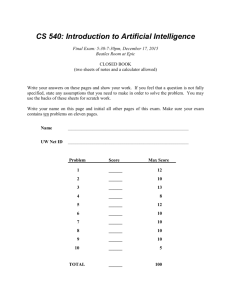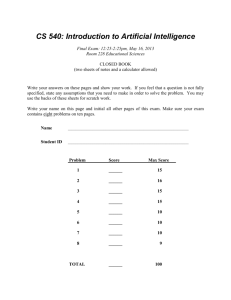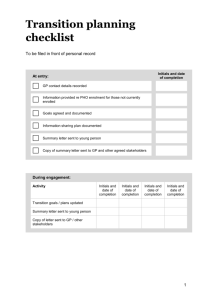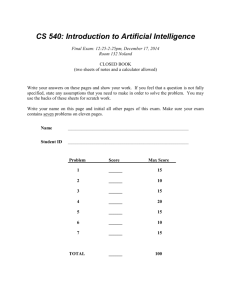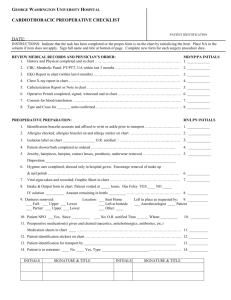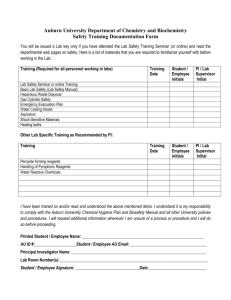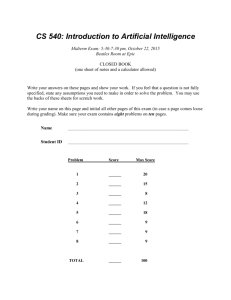final-fall11
advertisement
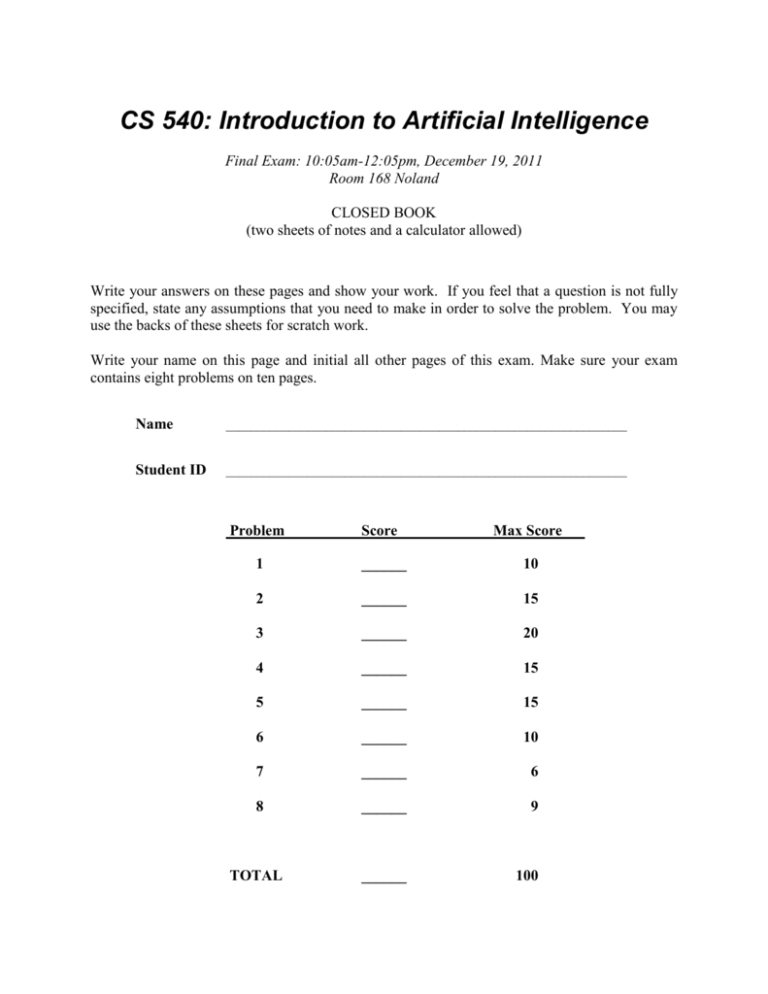
CS 540: Introduction to Artificial Intelligence
Final Exam: 10:05am-12:05pm, December 19, 2011
Room 168 Noland
CLOSED BOOK
(two sheets of notes and a calculator allowed)
Write your answers on these pages and show your work. If you feel that a question is not fully
specified, state any assumptions that you need to make in order to solve the problem. You may
use the backs of these sheets for scratch work.
Write your name on this page and initial all other pages of this exam. Make sure your exam
contains eight problems on ten pages.
Name
________________________________________________________________
Student ID
________________________________________________________________
Problem
Score
Max Score___
1
______
10
2
______
15
3
______
20
4
______
15
5
______
15
6
______
10
7
______
6
8
______
9
TOTAL
______
100
Initials:
________________________
Problem 1 – K-Nearest Neighbors (10 points)
Consider the training set below.
Ex #
A
B
C
D
Output
1
True True False True
True
2
True True True True
False
3
False False True False
True
4
False True False True
False
5
True True False False
True
6
True False True True
False
Assume you wish to use the K-nearest neighbors algorithm on this dataset and set aside the last
two examples as a tuning set.
Would you prefer K=1 or K=3?
Justify your answer below.
K = __________
2
Initials:
________________________
Problem 2 – Bayesian Networks (15 points)
Consider the following Bayesian Network, where variables A-D are all Boolean-valued:
A
P(A=true) = 0.2
A
B
P(C =true | A, B)
false
false
true
true
false
true
false
true
0.2
0.3
0.1
0.6
B
P(B=true) = 0.7
C
D
B
C
P(D =true | B,C)
false
false
true
true
false
true
false
true
0.9
0.8
0.4
0.3
a) What is the probability that all four of these Boolean variables are false? ______________
[Be sure to show your work for Parts a-c.]
b) What is the probability that A is true, C is true, and D is false?
_______________
c) What is the probability that A is true given that C is true and D is false? _______________
3
Initials:
________________________
Problem 3 – Probabilistic Reasoning and Learning (20 points)
a) In the general population, 5 in a 100,000 people have the dreaded Senioritis disease.
Fortunately, there is a test (test4it) for this disease that is 99.9% accurate. That is, if one has
the disease, 999 times out of 1000 test4it will turn out positive; if one does not have the
disease, 1 time out of 1000 the test will turn out positive.
You take test4it and the results come back true. Use Bayesian reasoning to calculate the
probability that you actually have Senioritis. That is, compute:
Prob(haveSenioritis = true | test4it = true)
=
_____________________________
Be sure to show your work below. It is fine if your answer is an arithmetic expression that
contains only numbers and *, /, +, and/or -. It is not necessary to plug the numbers into a
calculator and produce a single number as the answer.
4
Initials:
________________________
b) Consider the first five examples of Question 1’s training set again (copied below), but this
time use Naïve Bayes and do not create a tuning set.
Ex #
A
B
C
D
Output
1
True True False True
True
2
True True True True
False
3
False False True False
True
4
False True False True
False
5
True True False False
True
Calculate the ratio below, showing your work below it and putting your (numeric) answer on
the line to the right of the equal sign.
Prob(Output = True | A = False, B = False, C = False, D = False)
______________________________________________________ = ___________
Prob(Output = False | A = False, B = False, C = False, D = False)
c) Draw a Bayesian Network for the task in Part b that is different from Naïve Bayes, and
explain how it is different from Naïve Bayes. You only need to create the Conditional
Probability Table (CPT) for one node, but do use the data in the table in Part b.
5
Initials:
________________________
Problem 4 – Representing Knowledge with First-Order Logic (15 points)
Convert each of the following English sentences into First-Order Predicate Calculus (FOPC),
using reasonably named predicates, functions, and constants. If you feel a sentence is
ambiguous, clarify which meaning you’re representing in logic. (Write your answers in the
space below each English sentence.)
Everyone except Paul knows someone taller than they are.
Often students take cs540 the semester after they took cs367.
[You must use the notation of Markov Logic Networks here.]
Passing the ball from one player to another changes who has it, but not the team they are on.
[You must use situation calculus here.]
6
Initials:
________________________
Problem 5 – Propositional Reasoning (15 points)
a) Is the following wff valid, satisfiable, or unsatisfiable? Justify your answer formally.
(P Q) (P ¬ Q)
b) Put these wff’s in clausal form; show your work below and put your answers on the right.
(¬ P Q) (R ¬ S)
____________________________________
(P Q) (R S)
____________________________________
c) We wish to use search to find an interpretation that satisfies all the clauses below.
Show how this set of clauses can be simplified before starting the search.
Justify your simplification(s).
(P ¬ Q ¬ R ¬W)
(¬ P Q S)
(P Q ¬ R)
(P ¬ ¬ S)
(W)
7
Initials:
________________________
Problem 6 – FOPC Reasoning (10 points)
a) What is the most-general unifier (mgu), if any, of these two wff’s? ___________________
P(?x, ?y, ?y)
P(?y, f(1,?x), ?z)
b) Given the following background knowledge:
1. x { p(x) [ q(x) r(x) ] }
2. y [ q(y) p(y) ]
3. p(1)
4. p(2)
5. q(1)
6. q(2)
Show:
Number
z
r(z)
by filling out the table below, using as many lines as needed.
WFF
7.
8.
9.
10.
11.
12.
8
Justification
Initials:
________________________
Problem 7 – Neural Networks (6 points)
Consider a perceptron that has two real-valued inputs and an output unit that uses a step function
as its output function. All the initial weights and the output unit’s threshold equal 0.1. Assume
the teacher has said that the output should be 0 for the input in1 = 0.7 and in2 = 0.4.
Show how the perceptron learning rule (also called the delta rule) would alter this neural network
upon processing this training example. Let (the learning rate) be 0.25. You do not need to
adjust the output unit’s threshold during training.
Perceptron BEFORE Training
Perceptron AFTER Training
Did these changes improve the network? _________
Explain your answer.
9
Initials:
________________________
Problem 8 – Important AI Concepts (9 points)
Describe each of the following AI concepts and briefly explain its most significant aspect.
(Write your answers in the space below the AI concept.)
Tree Pruning
description:
significance:
Multiple Restarts
description:
significance:
Uniform Cost
description:
significance:
Have a good vacation!
10
